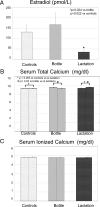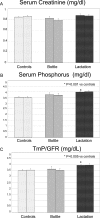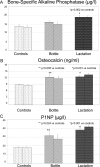Lactation and bone turnover: a conundrum of marked bone loss in the setting of coupled bone turnover
- PMID: 20150580
- PMCID: PMC2853989
- DOI: 10.1210/jc.2009-1518
Lactation and bone turnover: a conundrum of marked bone loss in the setting of coupled bone turnover
Erratum in
- J Clin Endocrinol Metab. 2011 Jul;96(7):2284-5
Abstract
Context: Mothers who exclusively breastfeed lose up to 10% of their bone mass. This is primarily mediated by PTHrP, in combination with low estrogen levels. The mechanisms underlying this marked bone loss are unknown. Uncoupling of bone turnover, which is seen in other prototypical states of bone loss, would seem the likely explanation. However, the most current markers of bone turnover have not been studied in human lactation.
Objectives: The purpose of this study was to assess bone formation in lactating humans using the most current bone turnover markers.
Design and participants: We conducted a prospective cohort study with repeated measures of bone metabolism in a volunteer sample of 49 women, recruited into three study groups: lactating, bottle feeding, and healthy controls. The postpartum women were studied at 6-8 and 12-14 wk postpartum, whereas the controls were studied at the follicular phase of their menstrual cycles.
Outcome measures: Biochemical markers of bone turnover were assessed.
Results: Mean serum C-telopeptide of type I collagen, a sensitive marker of bone resorption, was approximately 2-fold higher in lactating women as compared with bottle-feeding and healthy controls (P = 0.037 and P < 0.001, respectively). Surprisingly, amino-terminal telopeptides of procollagen 1, the most current marker of bone formation, bone-specific alkaline phosphatase, and osteocalcin were all significantly higher in the lactating group as compared with controls (P < 0.001, P = 0.002, and P < 0.001, respectively).
Conclusions: In contrast to prototypical states of rapid bone loss (myeloma, cancer, and immobilization) in which markers of bone turnover display marked uncoupling, lactational bone loss, as assessed in this small exploratory study, is distinct, showing comparably rapid bone loss in the face of apparent osteoclast-osteoblast coupling.
Figures





References
-
- Sowers M 1996 Pregnancy and lactation as risk factors for subsequent bone loss and osteoporosis. J Bone Miner Res 11:1052–1060 - PubMed
-
- Kovacs CS 2005 Calcium and bone metabolism during pregnancy and lactation. J Mammary Gland Biol Neoplasia 10:105–118 - PubMed
-
- Sowers MF, Hollis BW, Shapiro B, Randolph J, Janney CA, Zhang D, Schork A, Crutchfield M, Stanczyk F, Russell-Aulet M 1996 Elevated parathyroid hormone-related peptide associated with lactation and bone density loss. JAMA 276:549–554 - PubMed
-
- Kalkwarf HJ, Specker BL, Bianchi DC, Ranz J, Ho M 1997 The effect of calcium supplementation on bone density during lactation and after weaning. N Engl J Med 337:523–528 - PubMed
-
- Kovacs CS, Kronenberg HM 1997 Maternal-fetal calcium and bone metabolism during pregnancy, puerperium, and lactation. Endocr Rev 18:832–872 - PubMed
Publication types
MeSH terms
Substances
Grants and funding
LinkOut - more resources
Full Text Sources
Medical
Research Materials
Miscellaneous

